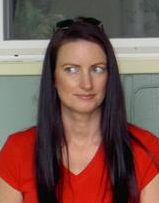Burning Woman: Art and Initiation in Hot, Dry Places
Following is a profile essay written in June 2011 for my English 1A class.
********
The elfin, middle-aged woman is curled into a fetal ball on the ground, her T-shirt pulled over her head to protect her eyes and face while a ferocious sandstorm painfully scours her slender limbs. It’s the first hour of Sharon Armstrong’s first time attending Burning Man, the social and artistic experiment held each August in an immense desert valley in Nevada. The scorching, utterly flat plain of the valley is known as “the playa.” Today, apparently, the playa wants to play rough.
 “I’d just arrived,” Sharon Armstrong, local artist, clinical psychologist and community activist remembers. “I walked out on the playa just to kinda see what in the world is this? What am I here for? A terrible sandstorm blew up and it was hotter than hell. I think I had on some cutoffs and a T-shirt. I felt like my skin was being sandblasted.” Her eyes widen behind her silver-rimmed glasses, marveling at the memory, “I could see nothing. I could remember reading something in their survival manual that, if you can’t get to a safe place, close your eyes and get down. So I just hit the ground, put my shirt up over my head and waited.”
“I’d just arrived,” Sharon Armstrong, local artist, clinical psychologist and community activist remembers. “I walked out on the playa just to kinda see what in the world is this? What am I here for? A terrible sandstorm blew up and it was hotter than hell. I think I had on some cutoffs and a T-shirt. I felt like my skin was being sandblasted.” Her eyes widen behind her silver-rimmed glasses, marveling at the memory, “I could see nothing. I could remember reading something in their survival manual that, if you can’t get to a safe place, close your eyes and get down. So I just hit the ground, put my shirt up over my head and waited.”
The few people passing by in the storm were far more sensibly outfitted than she for life in Black Rock City, the temporary metropolis built by Burning Man attendees. Wearing protective clothing and eye goggles, a few of them checked on Sharon’s condition before fading into the hammering, sand-saturated gale. Radical self-reliance is a key principle at Burning Man, but so is interdependence and community. “One guy stopped, and I knew it was a guy from his voice, and he said, ‘Are you okay?’ and I said, ‘Yeah.’ He took off his shirt, put it over me and rode off. I will never know who it was.”
Continue reading ‘Burning Woman: Art and Initiation in Hot, Dry Places’ »
 David Pogue, tech writer for the
David Pogue, tech writer for the  In addition to famous folks such as
In addition to famous folks such as 